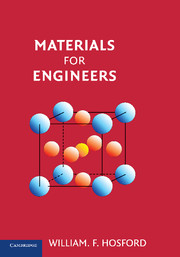Book contents
- Frontmatter
- Contents
- Preface
- 1 Introduction
- 2 Phases
- 3 Diffusion
- 4 Mechanical Behavior
- 5 Mechanical Failure
- 6 Annealing
- 7 Iron and Steel
- 8 Nonferrous Metals
- 9 Casting and Welding
- 10 Solid Shaping
- 11 Polymers
- 12 Polymer Processing
- 13 Glasses
- 14 Crystalline Ceramics
- 15 Powder Processing
- 16 Pottery and Concrete
- 17 Composites
- 18 Carbon
- 19 Fibers, Foams, and Porous Materials
- 20 Electrical Properties
- 21 Optical and Thermal Properties
- 22 Magnetic Materials
- 23 Corrosion
- 24 Modern Manufacturing Techniques, Surface Treatments, and Recycling
- APPENDIX 1 Wood
- APPENDIX 2 Miller Indices for Planes and Directions
- APPENDIX 3 X-ray Diffraction
- APPENDIX 4 Surfaces
- APPENDIX 5 Dislocations
- APPENDIX 6 Avrami Kinetics
- APPENDIX 7 Organic Chemistry
- APPENDIX 8 Average Molecular Weight
- APPENDIX 9 Bond Geometry in Compounds
- APPENDIX 10 Weibull Analysis
- Index
- Conversions
8 - Nonferrous Metals
Published online by Cambridge University Press: 05 June 2012
- Frontmatter
- Contents
- Preface
- 1 Introduction
- 2 Phases
- 3 Diffusion
- 4 Mechanical Behavior
- 5 Mechanical Failure
- 6 Annealing
- 7 Iron and Steel
- 8 Nonferrous Metals
- 9 Casting and Welding
- 10 Solid Shaping
- 11 Polymers
- 12 Polymer Processing
- 13 Glasses
- 14 Crystalline Ceramics
- 15 Powder Processing
- 16 Pottery and Concrete
- 17 Composites
- 18 Carbon
- 19 Fibers, Foams, and Porous Materials
- 20 Electrical Properties
- 21 Optical and Thermal Properties
- 22 Magnetic Materials
- 23 Corrosion
- 24 Modern Manufacturing Techniques, Surface Treatments, and Recycling
- APPENDIX 1 Wood
- APPENDIX 2 Miller Indices for Planes and Directions
- APPENDIX 3 X-ray Diffraction
- APPENDIX 4 Surfaces
- APPENDIX 5 Dislocations
- APPENDIX 6 Avrami Kinetics
- APPENDIX 7 Organic Chemistry
- APPENDIX 8 Average Molecular Weight
- APPENDIX 9 Bond Geometry in Compounds
- APPENDIX 10 Weibull Analysis
- Index
- Conversions
Summary
Aluminum
Aluminum and aluminum alloys are the most important nonferrous metals. Aluminum's density, ρ, is 2.7, which is about 1/3 of the density of iron. Its Young's modulus is 70 GPa (10 × 106 psi) which is also about 1/3 that of iron. The unique properties of aluminum that account for most of its usage are:
Good corrosion and oxidation resistance.
Good electrical and thermal conductivities.
Low density.
High reflectivity.
High ductility and reasonably high strength.
The uses of aluminum include foil, die castings, beverage cans, cooking and food processing, boats and canoes, and aircraft and automobile parts including sheet, engine blocks, and wheels. Aluminum's high reflectivity accounts for its use as foil for insulation and as reflective coatings on glass. Aluminum is used for power transmission lines and some wiring because of its high electrical conductivity. On an equal weight of cross section and equal cost bases, it is a better conductor than copper. Its high thermal conductivity is advantageous in its applications for radiators, air-cooled engines, and cooking utensils. The low density is important for lawn furniture, hand-held tools, and in cars, trucks, and aircraft. Aluminum's good strength and ductility is important in all structural uses where wrought products are used. Its chemical reactivity is important principally in its use in photoflash bulbs and the thermite reaction (Al + Fe2O3 → Fe + Al2O3). Its corrosion and oxidation resistance are important in packaging (foil, cans), architectural applications, and watercraft.
- Type
- Chapter
- Information
- Materials for Engineers , pp. 85 - 94Publisher: Cambridge University PressPrint publication year: 2008



